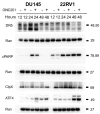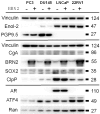Small cell lung cancer and prostate cancer cells with varying neuroendocrine differentiation markers show sensitivity to imipridone ONC201/TIC10
- PMID: 39959215
- PMCID: PMC11826210
- DOI: 10.62347/IBUS3598
Small cell lung cancer and prostate cancer cells with varying neuroendocrine differentiation markers show sensitivity to imipridone ONC201/TIC10
Abstract
Objectives: To investigate whether neuroendocrine differentiation (NED) markers, activation of the integrated stress response (ISR), and TRAIL pathway alter neuroendocrine tumor (NET) cell death and ONC201 sensitivity.
Methods: We conducted cell viability assays to determine ONC201 sensitivity. Western blot analysis was performed to evaluate NED, ISR, and TRAIL pathway markers. Expression levels of NED markers were compared between cell lines with and without BRN2 overexpression.
Results: Prostate cancer (PCa) and small cell lung cancer (SCLC) cell lines (N = 6) were sensitive to ONC201. Endogenous NET marker levels varied across PCa and SCLC cells. Transient BRN2 overexpression slightly reduced some NET markers while maintaining the sensitivity of PCa cells to ONC201.
Conclusions: PCa cell lines exhibit sensitivity to ONC201, with variability of NED features. These findings are relevant to the design of future studies evaluating imipridone efficacy in PCa and suggest that non-NET patients could be included in such studies.
Keywords: BRN2; ONC201; Prostate cancer; SOX2; neuroendocrine differentiation; small cell lung cancer.
AJTR Copyright © 2025.
Conflict of interest statement
W.S.E-D. is a co-founder of Oncoceutics, Inc., a subsidiary of Chimerix. Dr. El-Deiry has disclosed his relationship with Oncoceutics/Chimerix and potential conflict of interest to his academic institution/employer. He is fully compliant with NIH and institutional policy managing this potential conflict of interest.
Figures








Similar articles
-
Neuroendocrine differentiation (ND) in sensitivity of neuroendocrine tumor (NET) cells to ONC201/TIC10 cancer therapeutic.bioRxiv [Preprint]. 2024 Aug 30:2024.08.28.610183. doi: 10.1101/2024.08.28.610183. bioRxiv. 2024. PMID: 39257758 Free PMC article. Preprint.
-
Neuroendocrine prostate cancer drivers SOX2 and BRN2 confer differential responses to imipridones ONC201, ONC206, and ONC212 in prostate cancer cell lines.Am J Transl Res. 2024 Dec 15;16(12):7972-7982. doi: 10.62347/NBNQ6383. eCollection 2024. Am J Transl Res. 2024. PMID: 39822524 Free PMC article.
-
Neuroendocrine Prostate Cancer Drivers SOX2 and BRN2 Confer Differential Responses to Imipridones ONC201, ONC206, and ONC212 in Prostate Cancer Cell Lines.bioRxiv [Preprint]. 2024 Aug 30:2024.08.28.610184. doi: 10.1101/2024.08.28.610184. bioRxiv. 2024. Update in: Am J Transl Res. 2024 Dec 15;16(12):7972-7982. doi: 10.62347/NBNQ6383. PMID: 39257809 Free PMC article. Updated. Preprint.
-
ONC201 and imipridones: Anti-cancer compounds with clinical efficacy.Neoplasia. 2020 Dec;22(12):725-744. doi: 10.1016/j.neo.2020.09.005. Epub 2020 Oct 23. Neoplasia. 2020. PMID: 33142238 Free PMC article. Review.
-
Discovery and clinical introduction of first-in-class imipridone ONC201.Oncotarget. 2016 Nov 8;7(45):74380-74392. doi: 10.18632/oncotarget.11814. Oncotarget. 2016. PMID: 27602582 Free PMC article. Review.
References
-
- Siegel RL, Miller KD, Wagle NS, Jemal A. Cancer statistics, 2023. CA Cancer J Clin. 2023;73:17–48. - PubMed
-
- Bishop JL, Thaper D, Vahid S, Davies A, Ketola K, Kuruma H, Jama R, Nip KM, Angeles A, Johnson F, Wyatt AW, Fazli L, Gleave ME, Lin D, Rubin MA, Collins CC, Wang Y, Beltran H, Zoubeidi A. The master neural transcription factor BRN2 is an androgen receptor-suppressed driver of neuroendocrine differentiation in prostate cancer. Cancer Discov. 2017;7:54–71. - PubMed
-
- Haag P, Bektic J, Bartsch G, Klocker H, Eder IE. Androgen receptor down regulation by small interference RNA induces cell growth inhibition in androgen sensitive as well as in androgen independent prostate cancer cells. J Steroid Biochem Mol Biol. 2005;96:251–258. - PubMed
Grants and funding
LinkOut - more resources
Full Text Sources
